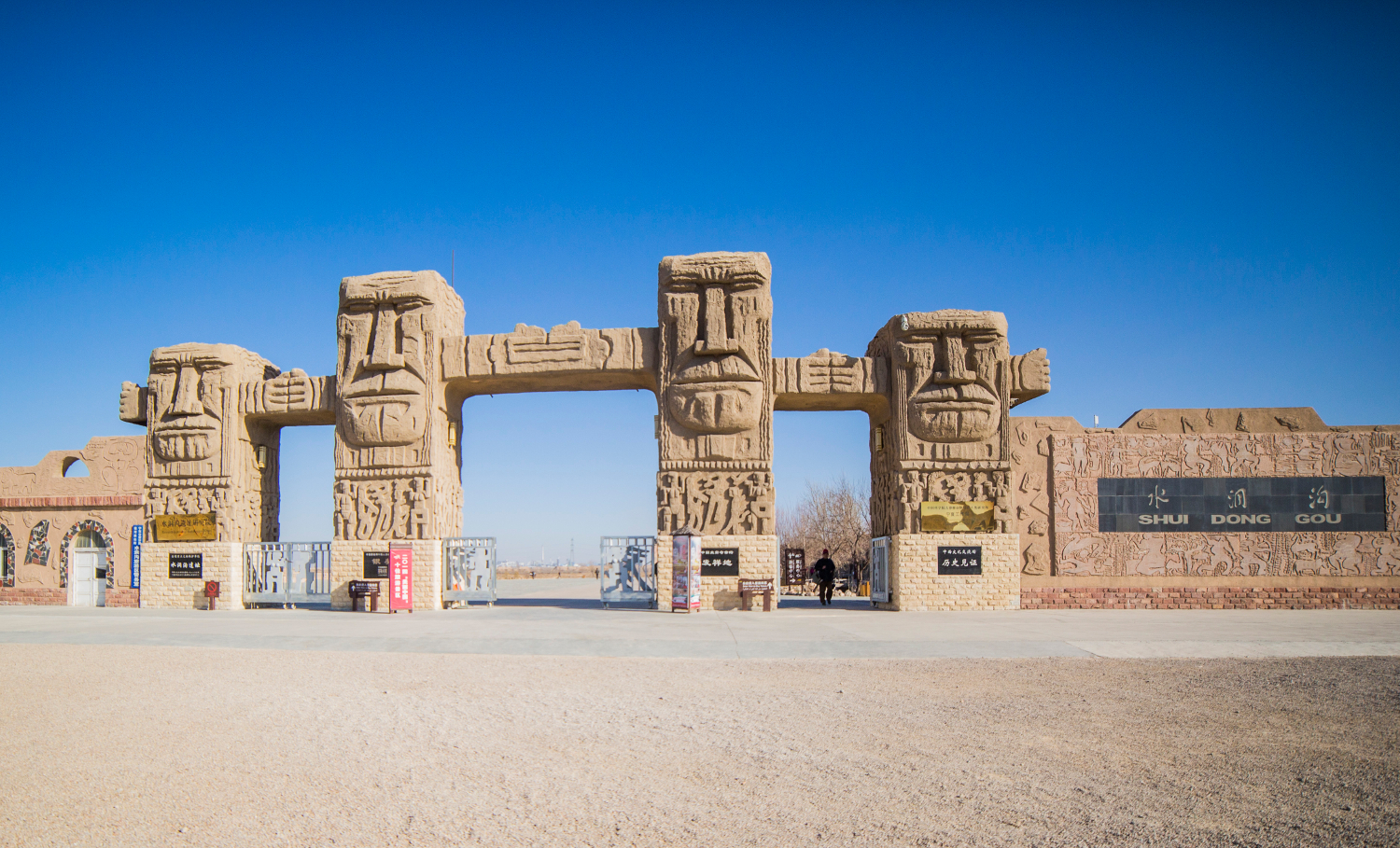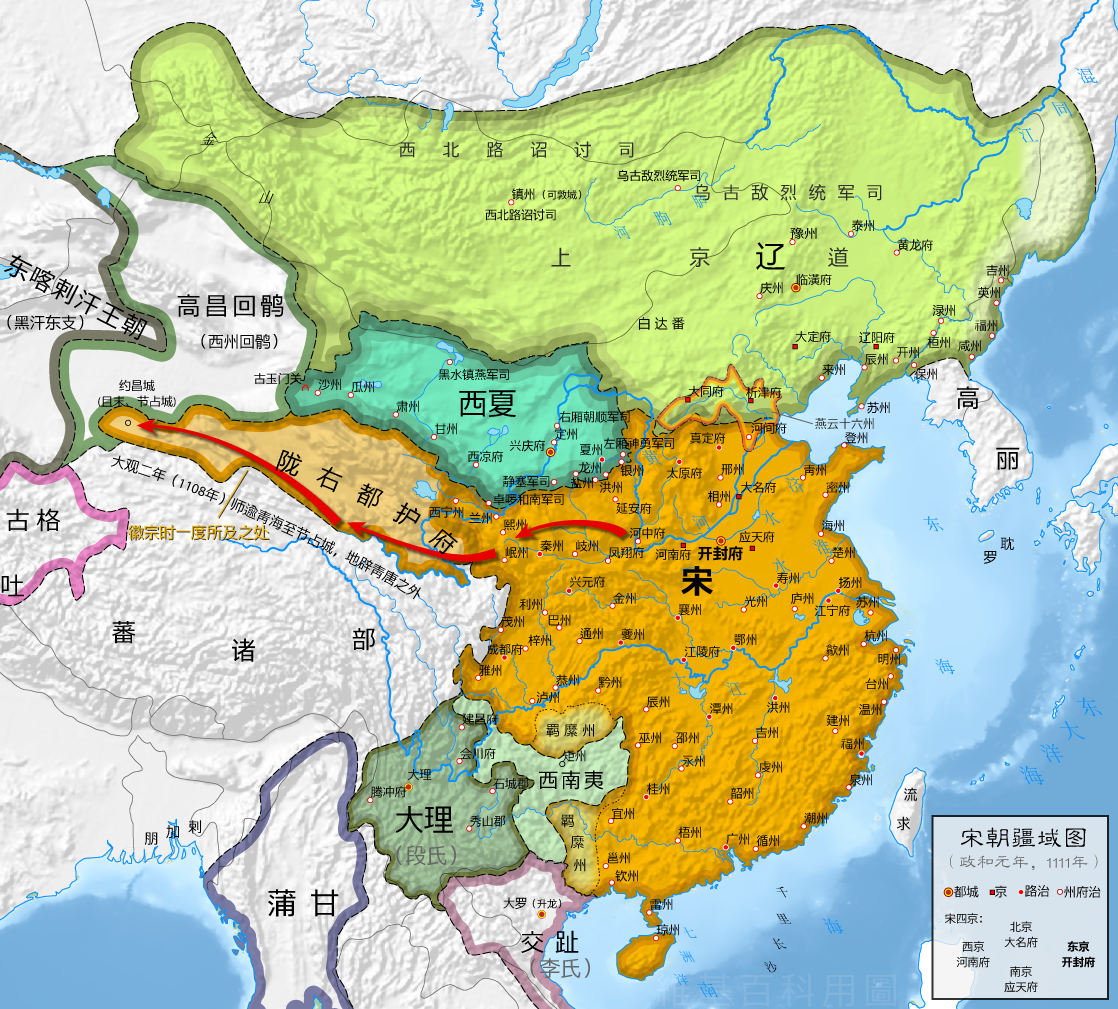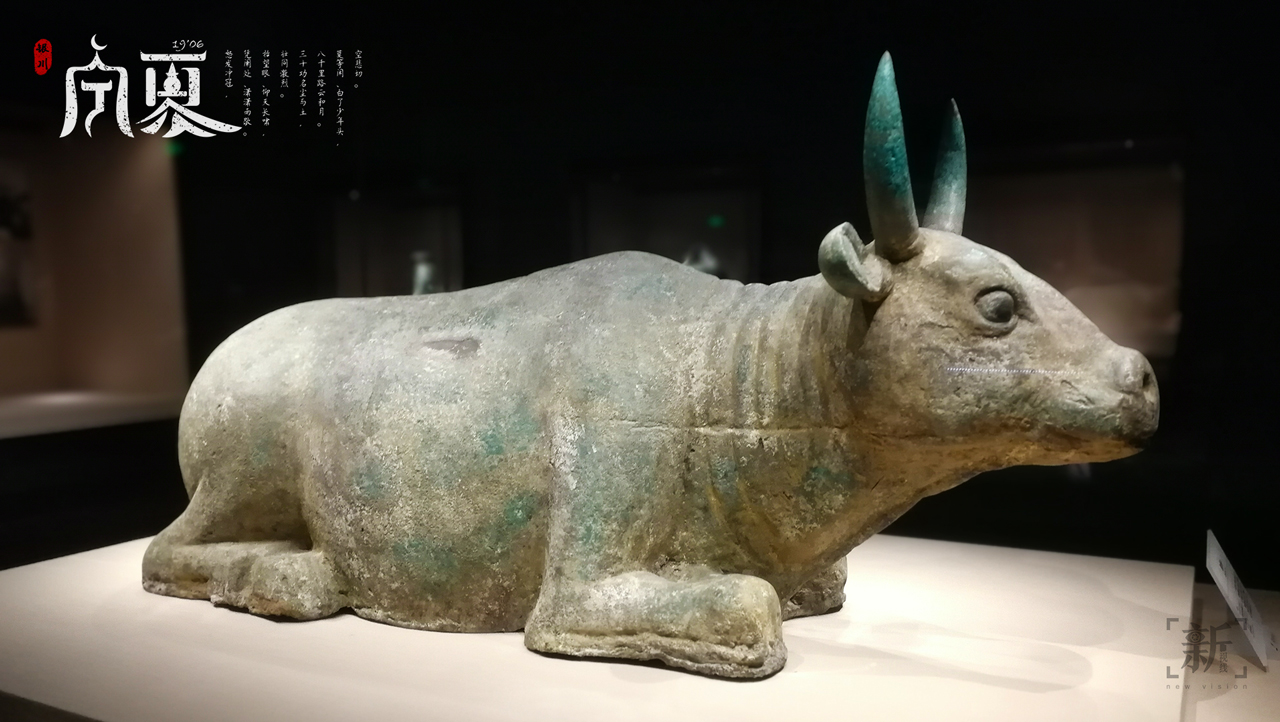
Deutsch-Chinesische Enzyklopädie, 德汉百科
 宁夏回族自治区-宁
宁夏回族自治区-宁

Shizuishan (chinesisch 石嘴山市, Pinyin Shízuǐshān Shì) ist eine bezirksfreie Stadt am Westufer des Gelben Flusses im Autonomen Gebiet Ningxia der Hui-Nationalität in der Volksrepublik China. Shizuishans Verwaltungsgebiet nimmt den gesamten Nordzipfel des Autonomen Gebiets ein. Es grenzt im Westen, Norden und Osten an das Autonome Gebiet Innere Mongolei und im Süden an die Yinchuan, die Hauptstadt Ningxias.

Die Shuidonggou-Stätte (chinesisch 水洞沟遗址, Pinyin Shuǐdònggōu yízhǐ) der Shuidonggou-Kultur (水洞沟文化, Shuǐdònggōu Wénhuà) aus dem späten Paläolithikum liegt auf dem Gebiet der Stadt Lingwu, Yinchuan, Autonomen Gebietes Ningxia der Hui-Nationalität in der Volksrepublik China. Es ist eine der frühesten in China entdeckten paläolithischen Stätten. Sie wird auf eine Zeit vor ca. 400.000 Jahren datiert.[1] Sie wurde unter anderem von dem belgischen Missionar Schotte untersucht.
宁夏水洞沟旅游景区是中国最早发掘的旧石器时代文化遗址,被誉为“中国史前考古的发祥地”、“中西方文化交流的历史见证”,被国家列为“最具中华文明意义的百项考古发现”之一。
水洞沟独特的雅丹地貌,鬼斧神工地造就了魔鬼城、旋风洞、卧驼岭、摩天崖、断云谷、怪柳沟等二十多处奇绝景观,记录了三万年前人类生生不息的活动轨迹。由“横城大边”、烽燧墩台、城障堡寨、藏兵洞窟等构成的古代长城立体军事防御体系,成为中国保存较为完整的军事防御建筑大观园。三万年前人类繁衍生息的圣地。1923年,法国古生物学家德日进、桑志华在这里发现了史前文化遗址,通过发掘,出土了大量石器和动物化石,水洞沟因此而成为我国最早发现旧石器时代的古人类文化遗址。
 安徽省-皖
安徽省-皖
 北京市-京
北京市-京
 福建省-闽
福建省-闽
 甘肃省-陇
甘肃省-陇
 广东省-粤
广东省-粤
 广西壮族自治区-桂
广西壮族自治区-桂
 贵州省-黔
贵州省-黔
 河北省-冀
河北省-冀
 河南省-豫
河南省-豫
 湖北省-鄂
湖北省-鄂
 湖南省-湘
湖南省-湘
 江苏省-苏
江苏省-苏
 江西省-赣
江西省-赣
 内蒙古自治区-内蒙古
内蒙古自治区-内蒙古
 宁夏回族自治区-宁
宁夏回族自治区-宁
 青海省-青
青海省-青
 陕西省-陕
陕西省-陕
 山东省-鲁
山东省-鲁
 陕西省-陕
陕西省-陕
 四川省-蜀
四川省-蜀
 天津市-津
天津市-津
 新疆维吾尔自治区-新
新疆维吾尔自治区-新
 浙江省-浙
浙江省-浙

唐朝(618年-907年),中国历史上的朝代,国祚共历289年,21位皇帝。由唐高祖李渊所建立。唐室出身自关陇世族,先祖李虎在南北朝的西魏是八柱国之一,封为唐国公[1]:254。其后代李渊为隋朝晋阳(在今山西太原西南)留守,在隋末民变时出兵入关中以争夺天下,于618年受隋恭帝杨侑禅位,在唐朝统一战争中统一天下。唐朝定都长安(今陕西省西安市),690年到705年为武周,定都神都洛阳[2]。
唐朝历史可以概略分成数个时期,大致上以安史之乱为界。初唐时国力强盛,李渊建立唐朝,是为唐高祖,其子秦王李世民以玄武门之变,杀害兄李建成、弟李元吉,逼迫高祖内禅帝位,即为唐太宗,是唐朝多次首都兵变的开端。太宗一手将唐朝带向盛世,击败强敌东突厥,受尊为“天可汗”,成就贞观之治。唐高宗时期击败西突厥、高句丽等强敌,建立永徽之治,把唐朝版图扩到最大。高宗去世后,其皇后武后先后拥立儿子中宗和睿宗当傀儡,最后于690年废睿宗自立为皇帝,改国号曰“周”,即武周,人称“武则天”,而此时女主政治也达到高峰。直到705年中宗因神龙革命而复辟,唐朝国号得以恢复。但接着还有韦后专权,之后宗室李隆基与其姑姑太平公主共同发起唐隆之变,才扫荡韦氏势力,结束自从中宗复辟后朝政紊乱的情况。李隆基也实际掌权,成为日后的唐玄宗。玄宗即位后便发动先天之变,赐死太平公主,结束数十年来的女主政治与百年来的政变时代,进入盛唐时期,是唐朝的第二高峰与转折,开元时期唐玄宗革除前朝弊端,政治开明,威服四周国家,史称开元盛世[3]:36。到天宝时期,政治逐渐混乱,于755年爆发安史之乱,唐朝盛极而衰。中唐时,唐朝受到河朔三镇、吐蕃的侵扰、宦官专权与牛李党争等内忧外患的影响而衰退。其间虽然有唐宪宗的元和中兴、唐武宗的会昌中兴与唐宣宗的大中之治,但是都未能根治唐朝的内忧外患。在晚唐时因为政治腐败,爆发唐末民变,其中黄巢之乱破坏江南经济,使唐朝经济完全瓦解,导致全国性的藩镇割据。唐室最后被藩镇朱全忠控制,他迫使唐昭宗迁都洛阳,并于907年逼唐哀帝禅位,唐灭亡,共289年。朱全忠建国梁,史称后梁,进入五代十国时期[4]:424。
唐朝的疆域广大,但时常变动,630年就超过隋朝极盛时的版图。唐朝也是自秦汉以来,第一个不使用前朝所筑长城及不筑长城的统一王朝[5][6][7]。其鼎盛时期为7世纪,当时中亚的绿洲地带受唐朝支配。其最大范围南至罗伏州(今越南河静)、北括玄阙州(今俄罗斯安加拉河流域)、西及安息州(今乌兹别克斯坦布哈拉)、东临哥勿州(今吉林通化)的辽阔疆域[8],国土面积达1076万平方千米[9]。中唐后漠北、西域的领地相继失去,到晚唐时衰退到等同中国本部的大小,但仍然保有河套地区及河西走廊[3]:36。天宝十三年(754年)户口统计为五千二百八十八万四百八十八人[10],不过许多学者考虑到当时统计不严,存在大量没有计入统计的瞒报户口[11],此外还有隐户、佃农、奴婢、士兵、僧道等人群不纳入户口统计,故大多数学者认为唐朝人口峰值在八千万左右[12][13][14]。此时,京兆府辖区人口估算在200万人左右,而市区则是100万人[15][16][17][18][19]。
唐朝在文化、科技、政治、经济、外交等方面都达到很高的成就。在中国历史上有大量的科技发明,四大发明中的火药即诞生于唐朝、雕版印刷开始广泛应用。其政治为三省六部制,前期中央权力在皇帝与宰相,中后期宦官影响力大增。同隋朝推行科举制度,使得晋朝南朝的世族制度不再兴起,中国历史上第一个状元、三元及第,都诞生于唐朝,即622年状元孙伏伽(一说651年的颜康成)[20]。军事制度前期采用府兵制,军力强盛,多次击败外族。后期则出现节度使(藩镇)的军政制度,割据一方,到唐朝后期还出现四十八个藩镇。唐朝是当时世界的强国,与突厥、高句丽、吐蕃、大食争夺四方霸权。借由羁縻制度控制回纥、契丹等北方各族,还调度漠北地区的突厥诸部军队攻打西突厥、高句丽[21],并且让南诏、高昌、龟兹、粟特、吐蕃、新罗、渤海国和日本等国家吸收唐朝的文化与政治体制[3]:38。唐朝的经济富盛,结合华北、关中与江南的经济,到后期更加依重江南赋税。土地、盐铁与赋税制度随着社会改变而改革,由均田制与租庸调制转向两税制,并且增加许多杂税。其中两税制影响中国后半期的赋税制度[4]:424。唐朝文化兼容并蓄,接纳各个民族与宗教,进行交流融合,成为开放的国际文化[22]:126。其文学发展达到高峰,以诗最为兴盛。当时有李白、杜甫等诗人,以及推行古文运动的韩愈,其史书与传奇(小说的前身)也十分发达。由于吸收西域特征与宗教色彩,唐朝艺术与前后朝代都迥然不同,其壁画、雕刻、书法与音乐都很发达[23]:758。唐朝声誉远及海外,其历史地位深重,到明清时期海外多称中国人为“唐人”[24]。
Die Tang-Dynastie (618-907) hatte 20 Kaiser und eine Kaiserin aus 14 Generationen und war mit einer Dauer von 289 Jahren die längste Dynastie in der chinesischen Geschichte. Davon fiel fast die Hälfte der Dauer mit fast 130 Jahren auf das sogenannte Goldene Zeitalter.
Aufstieg und Entwicklung zum Goldenen Zeitalter
唐(とう、拼音: 、618年 - 907年)は、中国の王朝である。李淵が隋を滅ぼして建国した。7世紀の最盛期には、中央アジアの砂漠地帯も支配する大帝国で、中央アジアや、東南アジア、北東アジア諸国、例えば朝鮮半島や渤海、日本などに、政制・文化などの面で多大な影響を与えた世界帝国である。日本の場合は遣唐使などを送り、894年(寛平6年)に菅原道真の意見でその回の遣唐使を中止し、結果としてそれ以降遣唐使は送られず、それまでは積極的な交流をしていた。首都は長安に置かれた。
690年に唐王朝は廃されて武周王朝が建てられたが、705年に武則天が失脚して唐が復活したことにより、この時代も唐の歴史に含めて叙述することが通例である。
日本では唐の滅亡後も唐、唐土の語はそれ以降の王朝、さらには外国全般を漠然と指す語として用いられた。しかし、天竺同様昔の呼称のため、正確に対応するわけではない。詳しくは中国を参照のこと。
The Tang dynasty (/tɑːŋ/;[4] Chinese: 唐朝[a]) or the Tang Empire was an imperial dynasty of China, preceded by the Sui dynasty and followed by the Five Dynasties and Ten Kingdoms period. Historians generally regard the Tang as a high point in Chinese civilization, and a golden age of cosmopolitan culture.[6] Tang territory, acquired through the military campaigns of its early rulers, rivaled that of the Han dynasty. The Tang capital at Chang'an (present-day Xi'an) was the most populous city in the world in its day.
The Lǐ family (李) founded the dynasty, seizing power during the decline and collapse of the Sui Empire. The dynasty was briefly interrupted when Empress Wu Zetian seized the throne, proclaiming the Second Zhou dynasty (690–705) and becoming the only Chinese empress regnant. In two censuses of the 7th and 8th centuries, the Tang records estimated the population by number of registered households at about 50 million people.[7][8] Yet, even when the central government was breaking down and unable to compile an accurate census of the population in the 9th century, it is estimated that the population had grown by then to about 80 million people.[9][10][b] With its large population base, the dynasty was able to raise professional and conscripted armies of hundreds of thousands of troops to contend with nomadic powers in dominating Inner Asia and the lucrative trade-routes along the Silk Road. Various kingdoms and states paid tribute to the Tang court, while the Tang also conquered or subdued several regions which it indirectly controlled through a protectorate system. Besides political hegemony, the Tang also exerted a powerful cultural influence over neighboring East Asian states such as those in Japan and Korea.
The Tang dynasty was largely a period of progress and stability in the first half of the dynasty's rule, until the An Lushan Rebellion and the decline of central authority in the later half of the dynasty. Like the previous Sui dynasty, the Tang dynasty maintained a civil-service system by recruiting scholar-officials through standardized examinations and recommendations to office. The rise of regional military governors known as jiedushi during the 9th century undermined this civil order. Chinese culture flourished and further matured during the Tang era; it is traditionally considered the greatest age for Chinese poetry.[11] Two of China's most famous poets, Li Bai and Du Fu, belonged to this age, as did many famous painters such as Han Gan, Zhang Xuan, and Zhou Fang. Scholars of this period compiled a rich variety of historical literature, as well as encyclopedias and geographical works. The adoption of the title Tängri Qaghan by the Tang Emperor Taizong in addition to his title as emperor was eastern Asia's first "simultaneous kingship".[12]
Many notable innovations occurred under the Tang, including the development of woodblock printing. Buddhism became a major influence in Chinese culture, with native Chinese sects gaining prominence. However, in the 840s the Emperor Wuzong of Tang enacted policies to persecute Buddhism, which subsequently declined in influence. Although the dynasty and central government had gone into decline by the 9th century, art and culture continued to flourish. The weakened central government largely withdrew from managing the economy, but the country's mercantile affairs stayed intact and commercial trade continued to thrive regardless. However, agrarian rebellions in the latter half of the 9th century resulted in damaging atrocities such as the Guangzhou massacre of 878–879.
La dynastie Tang (chinois : 唐朝 ; Wade : T'ang ; EFEO : T'ang, Ten quelquefois) (18 juin 618 - 1er juin 907) est une dynastie chinoise précédée par la dynastie Sui (581-618) et suivie par la période des Cinq Dynasties et des Dix Royaumes. Elle a été fondée par la famille Li, qui prit le pouvoir durant le déclin et la chute de l'empire Sui.
Venant après une longue période de division de la Chine qui dura de 220 à 581, à laquelle l'éphémère dynastie Sui avait mis fin, les premiers empereurs de cette dynastie eurent d'abord pour tâche de stabiliser l'empire récemment réunifié, et de lui redonner la puissance qu'avait eue la Chine à l'époque des Han. Ils firent rapidement mieux que ces derniers dans le domaine des conquêtes extérieures. Sous les premiers empereurs Tang (en particulier Taizong, l'impératrice Wu Zetian et Xuanzong), l'empire chinois connut une période de prospérité et un rayonnement culturel considérable. Sa capitale Chang'an, la plus grande ville du monde, reflétait toute la puissance et le cosmopolitisme, qui reposait notamment sur le dynamisme des échanges à longue distance le long de la route de la soie et des voies maritimes méridionales. Cette période a été vue par les générations suivantes comme un véritable âge d'or de la civilisation chinoise, symbolisé notamment par les brillants poètes Li Bai et Du Fu, et plus largement l'émergence d'un groupe de nombreux lettrés passés par les examens impériaux qui furent mis en place par les premiers empereurs Tang.
L'histoire de la dynastie bascula en 755 avec la révolte d'An Lushan, conséquence dramatique des évolutions politiques et militaires de l'empire à la période de son apogée. Après la difficile répression de ce soulèvement, l'organisation de l'empire se présenta sous un jour nouveau : la vieille aristocratie qui l'appuyait déclina irrémédiablement, supplantée par des hommes nouveaux disposant des charges militaires provinciales les plus importantes ou des grandes commissions fiscales et financières. Les empereurs ne parvinrent pas à contenir les forces centrifuges qui leur firent perdre l'autorité sur leurs provinces, même si cela n'entrava pas la prospérité de leur empire, portée par l'expansion démographique et économique des régions du Sud. Après une série de révoltes dans les dernières décennies du IXe siècle, la dynastie Tang s'éteint en 907, alors que son empire avait été dépecé. Les évolutions politiques, sociales, économiques et intellectuelles de cette période avaient déjà fait pénétrer la Chine dans une période que les historiens considèrent couramment comme « moderne », annonciatrice de la période de la dynastie Song (960-1272) qui réunifia la Chine quelques décennies après la fin des Tang.
Plusieurs innovations importantes sont apparues durant la dynastie Tang, dont le développement des caractères d'imprimerie en bois. Dans le domaine religieux, le bouddhisme eut une influence majeure dans la culture chinoise, avec l'affirmation de sectes bouddhistes aux racines spécifiquement chinoises et le développement d'un art remarquable. Toutefois, cette religion fut par la suite persécutée et son influence déclina, tandis que le taoïsme conservait une grande importance et que s'amorçait le retour du confucianisme, porté par les écrits de Han Yu.
La dinastia Tang (唐朝T, TángcháoP, 618-907) seguì la dinastia Sui, che aveva riportato l'unità politica in Cina, e fu seguita da un'epoca di disunione nota come il periodo delle Cinque dinastie e dieci regni.
Gli effetti del suddetto consolidamento iniziano a notarsi sotto l'imperatore Tai Zong (627 – 649), che ristabilisce il protettorato cinese sulla regione del bacino del Tarim (Asia centrale). Egli unisce la casa imperiale del Tibet alla Cina tramite matrimonio, intraprende la conquista della Corea e mantiene relazioni con il Giappone e i reami del Funan e del Champa. Con l'imperatore Xuan Zong (713 – 756) la Cina conosce un periodo di pace e prosperità, che favorisce il fiorire di produzioni artistiche.
La dinastía Tang (chino simplificado y tradicional: 唐朝, pinyin: Táng Cháo, Wade-Giles: T'ang2 Ch'ao2; ![]() tʰɑ̌ŋ tʂʰɑ̌ʊ̯ (?·i)) (618-907) fue la sucesora de la dinastía Sui y predecesora del período de las Cinco Dinastías y los Diez Reinos en China. La dinastía fue interrumpida por la segunda dinastía Zhou (690-705), cuando la emperatriz Wu Zetian usurpó el trono y fundó su propia dinastía. La dinastía Tang, con su capital en Chang'an (actual Xi'an), la ciudad más poblada del mundo en ese entonces, está considerada por los historiadores como un momento de esplendor de la civilización china, igual —o incluso superior— al del período Han.
tʰɑ̌ŋ tʂʰɑ̌ʊ̯ (?·i)) (618-907) fue la sucesora de la dinastía Sui y predecesora del período de las Cinco Dinastías y los Diez Reinos en China. La dinastía fue interrumpida por la segunda dinastía Zhou (690-705), cuando la emperatriz Wu Zetian usurpó el trono y fundó su propia dinastía. La dinastía Tang, con su capital en Chang'an (actual Xi'an), la ciudad más poblada del mundo en ese entonces, está considerada por los historiadores como un momento de esplendor de la civilización china, igual —o incluso superior— al del período Han.
Эпоха Тан (Династия Ли 李) (18 июня 618 — 4 июня 907, кит. 唐朝, Танчао) — китайская императорская династия, основанная Ли Юанем. Его сын, император Ли Шиминь, после окончательного подавления крестьянских восстаний и сепаратистских феодальных сил начал проводить прогрессивную политику. Именно эпоха Тан традиционно считается в Китае периодом наивысшего могущества страны, когда она опережала остальные современные ей страны мира в своём развитии.

Tengger Desert Solar Park is the world's largest photovoltaic plant. It is located in Zhongwei, Ningxia, China. It currently covers a larger area (43 km2) and has a larger peak power output (1,547 MW) than any other.

西夏(1038年-1227年),国号大夏、邦泥定国(西夏文:![]() ,拉丁转写:phôn¹ mbın² lhi̯ə tha²)或白高大夏国(西夏文:
,拉丁转写:phôn¹ mbın² lhi̯ə tha²)或白高大夏国(西夏文:![]() )等[b],是中国历史上由党项族建立的一个朝代。主要以党项族为主体,包括汉族、回鹘族与吐蕃族等民族在内的国家。因位于中原地区的西北方,国土占据黄河中上游,史称西夏[5]。
)等[b],是中国历史上由党项族建立的一个朝代。主要以党项族为主体,包括汉族、回鹘族与吐蕃族等民族在内的国家。因位于中原地区的西北方,国土占据黄河中上游,史称西夏[5]。
党项族原居四川松潘高原,唐朝时迁居陕北。因平乱有功被唐帝封为夏州节度使,先后臣服于唐朝、五代诸朝与宋朝。夏州政权被北宋并吞后,由于李继迁不愿投降而再次立国,并且取得辽帝的册封。李继迁采取连辽抵宋的方式,陆续占领兰州与河西走廊地区。1038年11月10日李元昊称帝建国,即夏景宗,西夏正式立国。西夏在宋夏战争与辽夏战争中大致获胜,形成三国鼎立的局面。夏景宗去世后,大权掌握在皇帝的太后与母党手中,史称母党专政时期。西夏因为皇党与母党的对峙而内乱,北宋趁机多次伐夏。西夏抵御成功并击溃宋军,但是横山的丧失让防线出现破洞。金朝崛起并灭辽、北宋,西夏改臣服金朝,获得不少土地,两国建立金夏同盟而大致和平。夏仁宗期间发生天灾与任得敬分国事件,但经过改革后,到天盛年间出现盛世。然而漠北的蒙古帝国崛起,六次入侵西夏后拆散金夏同盟,让西夏与金朝自相残杀。西夏内部也多次发生弑君、内乱之事,经济也因战争而趋于崩溃。最后于1227年8月28日亡于蒙古[5]。
西夏属于番汉联合政治,以党项族为主导,汉族与其他族群为辅。制度由番汉两元政治逐渐变成一元化的汉法制度。西夏的皇权备受贵族、母党与权臣等势力的挑战而动荡不安[6]。由于处于列强环视的河西走廊与河套地区,对外采取依附强者,攻击弱者、以战求和的外交策略[7]。军事手段十分灵活,配合沙漠地形,采取有利则进,不利则退,诱敌设伏、断敌粮道的战术;并且有铁鹞子、步跋子与泼喜等特殊兵种辅助[8]。经济方面以畜牧业与商业为主力,对外贸易易受中原王朝的影响,垄断河西走廊与北宋的岁币为西夏经济带来很大的帮助[9]。
西夏是一个佛教王国,兴建大量的佛塔与佛寺,以承天寺塔最有名。然而也是崇尚儒学汉法的帝国,立国前积极汉化;虽然夏景宗为了维护本身文化而提倡党项、吐蕃与回鹘文化,并且创立西夏文、立番官、建番俗等措施;但自夏毅宗到夏仁宗后,西夏已经由番汉同行转为普遍汉化[6]。文学方面以诗歌和谚语为主。在艺术方面于敦煌莫高窟、安西榆林窟有丰富的佛教壁画,具有“绿壁画”的特色。此外在雕塑、音乐与舞蹈等方面都有独特之处[10]。
Das Reich der Westlichen Xia-Dynastie oder Xi Xia (chinesisch 西夏, Pinyin Xī Xià; tangutisch: Mi-Nyak[1]) wurde 1038 von den Tanguten auf dem Gebiet der heutigen chinesischen Provinz Gansu und des heutigen Autonomen Gebiets Ningxia, mit Zentrum bei Yinchuan, gegründet.
Es handelte sich um einen Vielvölkerstaat Chinas, mehrheitlich bewohnt von Tanguten aber auch Uiguren, Han-Chinesen, Mongolen und Tibetern. Die Führungsspitze des Staates bildeten Tanguten. Tibeter, Uiguren und Han-Chinesen waren aber in politischen Ämtern aktiv.[2] Es gab in ihrem Staat entsprechend den geographischen Gegebenheiten sowohl Ackerbauern, wie auch Karawanenhändler, Nomaden und Halbnomaden.
Das Tangutenreich war aufgrund der Schwäche der Song-Dynastie seit dem 11. Jahrhundert unabhängig, stand aber unter starkem Einfluss der chinesischen Kultur. Es vermittelte den Handel und Schmuggel entlang der Seidenstraße; Haupthandelspartner war dabei die Song-Dynastie. 1044 mussten sich die Song sogar zu Tributzahlungen (Seide, Silber, Tee) an die Tanguten verpflichten. Im Jahr 1226/1227 wurde der Staat Xi Xia von den Mongolen beseitigt.
西夏(せいか、西夏文字:![]() [*phiow¹-bjij²-lhjij-lhjij²]、1038年 - 1227年)は、タングートの首長李元昊が現在の中国西北部(甘粛省・寧夏回族自治区)に建国した王朝。国号は夏だが、中国最古の王朝夏などと区別するため、通例「西」の字を付して呼ぶ。首都は興慶(現在の銀川)。モンゴル帝国のチンギス・カンによって滅ぼされた。
[*phiow¹-bjij²-lhjij-lhjij²]、1038年 - 1227年)は、タングートの首長李元昊が現在の中国西北部(甘粛省・寧夏回族自治区)に建国した王朝。国号は夏だが、中国最古の王朝夏などと区別するため、通例「西」の字を付して呼ぶ。首都は興慶(現在の銀川)。モンゴル帝国のチンギス・カンによって滅ぼされた。
The Western Xia or Xi Xia (Chinese: 西夏; pinyin: Xī Xià; Wade–Giles: Hsi1 Hsia4), also known to the Mongols as the Tangut Empire and to the Tangut people themselves and to the Tibetans as Mi-nyak,[3] was an empire which existed from 1038 to 1227 in what are now the northwestern Chinese provinces of Ningxia, Gansu, eastern Qinghai, northern Shaanxi, northeastern Xinjiang, southwest Inner Mongolia, and southernmost Outer Mongolia, measuring about 800,000 square kilometres (310,000 square miles).[4][5][6] Its capital was Xingqing (modern Yinchuan), until its destruction by the Mongols in 1227. Most of its written records and architecture were destroyed, so the founders and history of the empire remained obscure until 20th-century research in the West and in China.
The Western Xia occupied the area round the Hexi Corridor, a stretch of the Silk Road, the most important trade route between North China and Central Asia. They made significant achievements in literature, art, music, and architecture, which was characterized as "shining and sparkling".[7] Their extensive stance among the other empires of the Liao, Song, and Jin was attributable to their effective military organizations that integrated cavalry, chariots, archery, shields, artillery (cannons carried on the back of camels), and amphibious troops for combat on land and water.[8]
La dynastie des Xia Occidentaux (chinois : 西夏 ; pinyin : ), gouvernait, de 1032 à 1227 selon l'historiographie chinoise, l'État appelé « royaume des Xia occidentaux » (Xixia) par les Chinois Han, « Empire tangoute » (Тангуд улс) par les Mongols et « Minyak » par les Tibétains1. Le territoire de cet État fondé par les Tangoutes, un peuple de langue tibéto-birmane, correspondait approximativement aux actuelles provinces chinoises du Gansu, du Shaanxi, du Ningxia, à l'est du Qinghai, au nord du Shaanxi, au nord-est du Xinjiang, au sud-ouest de la Mongolie intérieure et au sud de la Mongolie. Le tout représente une surface de 800 000 km22,3,4 et recouvre le nord-ouest de la Chine. Au XIIe siècle, la capitale est déplacée à Khara-Khoto, qui reste le centre du pouvoir jusqu'à sa destruction en 1227 par les troupes de Genghis Khan, le fondateur de l'Empire mongol. En même temps que la cité, toutes les archives écrites du royaume sont brulées, ce qui explique que l'histoire de ce royaume reste longtemps connue de l'Occident uniquement grâce aux documents chinois. Ce n'est qu'en 1907 que le site de la capitale est découvert par l'explorateur russe Piotr Kouzmitch Kozlov et que les fouilles qui s'ensuivent permettent d'en savoir plus sur ce peuple.
Le territoire des Xia occidentaux se situe autour du corridor du Hexi, une des portions de la route de la soie, qui est alors la route commerciale la plus importante entre le nord de la Chine et l'Asie centrale. Tout au long de leur existence, les Xia font des progrès importants dans la littérature, l'art, la musique et l'architecture, qui a été décrite comme étant « rayonnante et étincelante »5. Leur existence même et leur maitrise d'un territoire aussi important alors qu'ils sont frontaliers de puissants empires rivaux tels que les Liao, les Song et les Jin; s’explique par leur organisation militaire efficace qui combine cavalerie, chars, archers, fantassins protégés, artillerie (canons primitifs portés à dos de chameaux) et troupes amphibies exercées au combat sur terre et l’eau6.
La dinastia Xia Occidentale regnò dal 1038 al 1227 nell'impero Xi Xia (cinese: 西夏T, Xī XiàP, Hsi HsiaW detto anche Xia Occidentale o impero tangut, dal nome del popolo che lo componeva. Questo popolo ed il territorio in cui viveva era noto sia ai tanguti che ai tibetani anche con il nome Minyak.
L'impero tangut si spartì il territorio cinese con altre dinastie, tra le quali le principali furono quella dei Song (960-1279), dei Liao (907-1125) e dei Jīn (1115-1234).
Nel periodo di massima espansione l'impero comprendeva le attuali province cinesi del Ningxia, del Gansu, la parte orientale del Qinghai, il nord dello Shaanxi, il nord-est del Xinjiang, il sud-ovest della Mongolia interna ed il sud della Mongolia, e si estendeva per circa 800.000 chilometri quadrati.[1][2][3]
Gli Xia occidentali controllarono lo strategico corridoio di Hexi, il passaggio settentrionale della via della seta, riuscendo a resistere alle pressioni dei vicini imperi Liao, Song, e Jīn, in virtù dell'allora moderna organizzazione militare che si diedero, sfruttando al meglio la cavalleria, i carri da guerra, gli arcieri, l'artiglieria, i cui cannoni erano trasportati da cammelli, ed i mezzi anfibi.
I tangut si distinsero anche nei campi della letteratura, dando vita ad una propria scrittura, delle arti e dell'architettura, che fu definita "splendente e scintillante".[4]
El Imperio tangut, también conocido por el nombre chino de Imperio Xia Occidental o Imperio de Xi Xia (chino: 西夏, Wade-Giles: Hsi1 Hsia4, pinyin: Xī Xià) fue un estado que existió entre los años 982 y 1227 en el noroeste del territorio actual de la República Popular China.
Situado en parte del territorio ocupado en la actualidad por las provincias de Gansu y Shaanxi y por la Región Autómoma Hui de Ningxia, el estado fue fundado por los tangut, un pueblo nómada que descendía de los Tuoba o Tabgach, el pueblo que había fundado la dinastía china de los Wei del Norte. Los tangut tenían su propia lengua, el tangut, caracterizado por un complejísimo sistema de escritura compuesto por miles de caracteres, la inmensa mayoría de los cuales no ha podido ser descifrada.
Си Ся (кит. 西夏, пиньинь: Xī Xià), Западное Ся, Да Ся (кит. 大夏, пиньинь: Dà Xià), Великое Ся, Тангутское царство, Великое государство Высокой Белизны[1] (официальное название Великое государство Белого и Высокого) — государство тангутов, существовавшее в 1038—1227 годах к северо-западу от китайского царства Сун и, позднее, чжурчжэньского Цзинь на территории современных китайских провинций Шэньси и Ганьсу. Контролировало восточный отрезок Великого шёлкового пути.
 地理
地理


 历史
历史

 能源
能源

 体育
体育

 建筑艺术
建筑艺术


